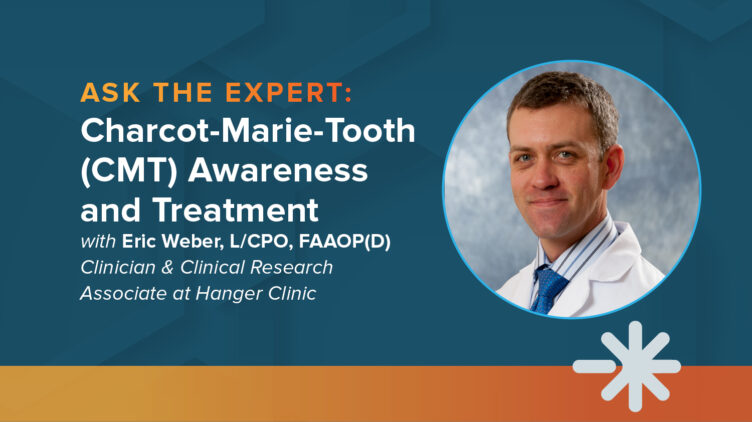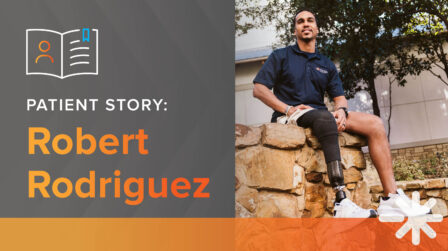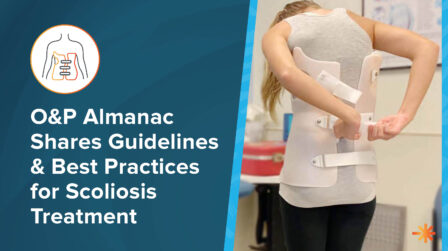Ask the Expert: Charcot-Marie-Tooth (CMT) Awareness and Treatment

September is Charcot-Marie-Tooth (CMT) Awareness Month. CMT, also known as hereditary motor and sensory neuropathy, is one of the most common inherited neurological disorders, affecting an estimated 126,000 individuals in the United States and 2.6 million people worldwide.1 We sat down with Eric Weber, L/CPO, FAAOP(D), to understand more about CMT and how to increase mobility with the disease.
Eric Weber, L/CPO, FAAOP(D)
Certified Prosthetist/Orthotist, Hanger Clinic
Eric is an ABC-certified prosthetist/orthotist at Hanger Clinic in Renton, Washington. Eric actively participates in the education, research, and development of orthotic and prosthetic technologies. He currently divides his time between patient care and his role within Clinical and Scientific Affairs.

1. What is Charcot-Marie-Tooth?
Charcot-Marie-Tooth (CMT) is a group of inherited disorders that cause damage to the peripheral nerves. These are the nerves that transmit information and signals from the brain and spinal cord to and from the rest of the body. The damage is mostly in the nerves that control the muscles in the arms and legs.
2. When is CMT typically diagnosed?
Nearly all cases of CMT are inherited. Symptoms of CMT typically appear in adolescence or early adulthood, but may also develop in midlife.
3. What are the signs of CMT?
Symptoms usually begin in the feet and legs, but they may eventually affect your hands and arms. Signs and symptoms of CMT may include:2
- Weakness in your legs, ankles, and feet
- Smaller muscles in your legs and feet
- Foot deformities, such as high foot arches or curled toes (hammertoes)
- Difficulty walking and decreased ability to run
- Difficulty lifting your foot at the ankle (footdrop)
- Awkward or higher than normal step (gait)
- Frequent tripping or falling
- Decreased sensation or a loss of feeling in your legs and feet
As CMT progresses, symptoms may spread from the feet and legs to the hands and arms. The severity of symptoms can vary greatly from person to person, even among family members. Your physician may recommend tests including nerve conductions studies, electromyography (EMG), nerve biopsy, or genetic testing to help provide information about the extent of your nerve damage and what may be causing it.
4. What causes CMT?
CMT an inherited, genetic condition. It occurs when there are mutations in the genes that affect the nerves in your feet, legs, hands, and arms. Sometimes, these mutations damage the nerves. Other mutations damage the protective coating that surrounds the nerve (myelin sheath). Both cause weaker messages to travel between your limbs and brain.
5. What are the complications of CMT?
Complications of CMT vary in severity from person to person. Foot abnormalities and difficulty walking are usually the most serious problems. Muscles may get weaker, and you may experience injuries in areas of the body that experience decreased sensation.
Sometimes the muscles in your feet may not receive your brain’s signal to contract, so you’re more likely to trip and fall. Additionally, your brain may not receive pain messages from your feet. As an example, this may cause a blister caused by rubbing on your toe to get infected without you knowing it.
6. How is CMT treated?
CMT generally progresses slowly. There is no cure, but there are treatments to help manage it.
- Foot care. Foot deformities and loss of sensation are associated with CMT. Regular foot care such as inspecting your feet, taking care of your nails, and wearing the right shoes is important to help relieve symptoms and to prevent complications.
- Physical therapy. Physical therapy can help strengthen and stretch your muscles to prevent muscle tightening and loss. Exercise and stretching at home as directed by your physician can also help and improve stability.
- Occupational therapy. Weakness in the arms and hands can cause difficulty with gripping and finger movements, such as fastening buttons or writing. Occupational therapy can help through the use of assistive devices.
- Orthotic devices. Many people with CMT may require orthotic devices to maintain function and mobility. The certified orthotists at Hanger Clinic understand how the different types of CMT present clinically and have expertise across a full range of orthotic devices, including custom ankle-foot orthoses (AFOs), to assist in daily activities such as walking and climbing stairs.
7. What can you expect with an AFO?
- Upon receiving a prescription for the brace, you will schedule a free evaluation with your nearest Hanger Clinic.
- At the initial evaluation, the orthotist will provide you with education and information on the process for obtaining bracing. The initial evaluation will include an analysis of movement abilities, and where appropriate, walking patterns. Next, they will take an impression and gather the appropriate measurements for bracing. During this appointment, you will likely have the opportunity to help design the appearance of the orthosis. Your clinician will send the impression(s), measurements, and scans (if applicable) to a design center where the brace will be fabricated. At the same time, the office staff will work to verify insurance coverage, with the goal of providing you with an understanding of your out-of-pocket costs (due to your deductible and coinsurance).
- In 3-6 weeks, you will return to the clinic for fitting and delivery of the orthosis. At that time, the orthotist will evaluate and adjust the brace(s) to ensure a comfortable fit and proper function. They will review the break-in schedule and cleaning instructions, show you how to put them on and take them off, and schedule necessary follow-up appointments. Some more complicated cases may require more than one fitting appointment.
- In 2-8 months, you will return to assess the brace fit and address any concerns you may have. Your clinician will also take the time to answer questions and recommend a schedule for follow-up appointments.
- During future follow-up appointments, your clinician will assess the fit and function of the brace.
Meet Julie Stone, CMT Advocate
Julie Stone is an adaptive fitness instructor, podcast enthusiast, and experienced traveler. At a young age, Julie started having symptoms of foot drop and lower-limb weakness. She was later diagnosed with CMT. Julie was fit with ankle-foot orthoses (AFOs) by Hanger Clinic clinician Eric Weber.
As an advocate for self-acceptance and a champion for breaking down stereotypes of people with disabilities, Julie has made it her mission to help others.

8. Is an AFO comfortable to wear?
It usually takes 1-2 weeks to get used to wearing an orthosis, which is why orthotists allow for a gradual break-in schedule. While there may be areas of redness that correspond with the areas of pressure the brace is providing, there shouldn’t be blisters or sores associated with the bracing. Your orthotist will advise on how to best address red spots based on each individual case.
9. What advice would you give to those just starting out in their journey with CMT?
My advice would be to be patient with the process, ask questions, and understand the goals of your orthosis. Work with your entire team of clinicians to help achieve your best mobility and functional goals.
Visit the Charcot-Marie-Tooth Association for more information on living with CMT.
Request a Free Evaluation
If you or someone you love is looking for personalized orthotic care, get in touch with a board-certified orthotist at a Hanger Clinic near you.
Latest Updates
Subscribe to stay up-to-date on our latest posts.



